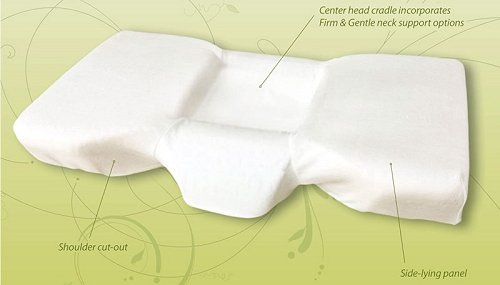Ergonomic Cervical Pillows For Sleeping That Provide Calculated Optimal Support
The majority of individuals sleep in side posture and this tendency increases as we grow older along with greater periods of posture immobility lasting between 45 and 110 minutes. Having a proclivity towards greater immobility, the best selection of ergonomic cervical pillows is essential in order to prevent the adverse consequences of altered sleeping posture.
Even though escalating periods of immobility tend to be observed, adults tend to change postures eleven to thirteen times every night. It is therefore important to utilize pillows that use ergonomic principles to achieve the best reduction of anatomical stress to maximize pain reduction and restorative sleep. Functional pillows seek to achieve this goal.
Inadequate head position throughout the night impacts pain susceptible structures connected with the cervical spine and may result in stiff muscles on waking, headaches, as well as shoulder and/or arm numbness, tingling or pain. Cervicogenic headaches are usually associated with the top segments of the neck or upper cervical spine, whereas shoulder and arm pain may be referred through the lower segments; therefore ergonomic cervical pillows should offer support for all related spinal elements.
Consequently, pillow posture might be associated with distinct regions as headaches may suggest rotational torsion coming from pillows which don’t give you the proper neutral position within rotational planes, whereas shoulder and/or arm discomfort might point to pillows which lacking support within sagittal or back/front planes.
Similarly, pillows that are ergonomically designed must also supply support within the right and left flexion plane that may relate with shoulder as well as arm pain and/or pins and needles. Within the side posture using the left side upward, pillows which are situated too high might result in excessive stretching out from the right side of the shoulder and neck muscle groups, and compress nerves and/or blood vessels associated with the left side with the neck.
Common human health problem consists of pain and tension in the head, neck and shoulders. This problem may arise in an otherwise healthy person due to improper support of the head, neck and shoulders during sleeping. Additionally, many injuries and conditions, such as whiplash, sprains, strains, arthritis and disc syndromes may increase the need for optimal head and neck support during sleeping to promote healing or reduce flare-ups. The pain and tension may cause associated problems such as insomnia, restlessness, light sleep, and snoring.
Ergonomically, the best position of the neck is called the neutral position. This position corresponds substantially to the most anatomically natural position of the cervical spine of a person who is standing upright with correct posture. In the neutral position, the lordotic curve of the neck is maintained such that the least stress is placed on the cervical vertebrae and surrounding connective tissues, and the minimum amount of stress is maintained.
When the head and neck are not in the best position, the circulation of blood and nutrients through the neck is restricted due to stressed connective tissue and vessels. Additionally, sub-optimal neck position can place stress on the nerves causing neurological instability of the vasomotor and muscular mechanical reflexes. Sub-optimal sleeping posture may also constrict breathing, which can cause or exacerbate snoring, sleep apnea, and other related disorders.
Humans recline in many positions during rest, including supine (on one’s back), lateral (on one’s left or right side), and the prone (on one’s stomach). Ergonomic cervical pillows are designed to best support the head and neck in either the supine or a lateral position, such that the best neutral cervical posture is maintained in either position.
Therefore, the best support strategy is essential to minimize strain to the head, neck and shoulders, therefore decreasing pressure points involving muscle, ligaments, bursa, as well as bony areas. This ergonomic design increases blood flow for the skin and connective tissue in order to supply improved oxygen.
- A 2019 study in the American Journal of Physical Medicine & Rehabilitation found an ergonomic latex pillow showed pain relief, a decrease in decreased disability, and increased range of motion in all directions significantly compared with routine physical therapy alone in patients with cervical spondylosis.
The most effectively developed ergonomic pillows minimize pressure around the arms and shoulders from the side posture and provides a restorative cervical posture, while providing a gentle, comfortable surface area in order to adapt to other possible sensitive areas like the jaw and face. Support in the supine/face-up posture promotes the balanced natural lordotic curve within the cervical spine.
Pillows can be designed to supply a small amount of beneficial traction or decompression to the neck. This kind of traction, or sometimes called decompression, typically enhances intra-articular blood flow, reduces muscular tension, enhances general circulation as well as relieves pressure within the spinal discs.
For more information on ergonomic cervical pillows, please see ergonomics of cervical pillows and how to choose the right pillow to become familiar with the types, functions, and how these factors relate to sleeping habits.



